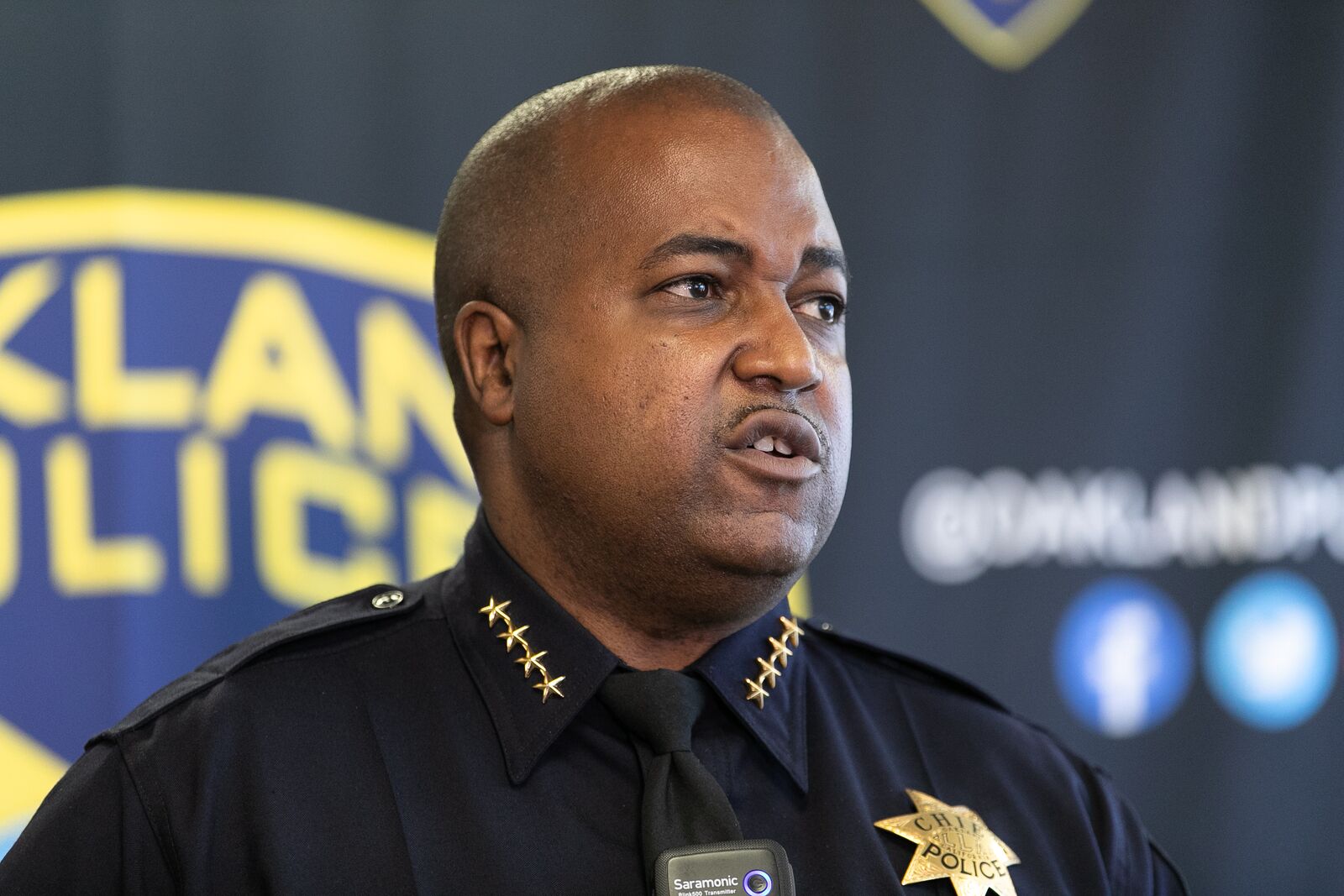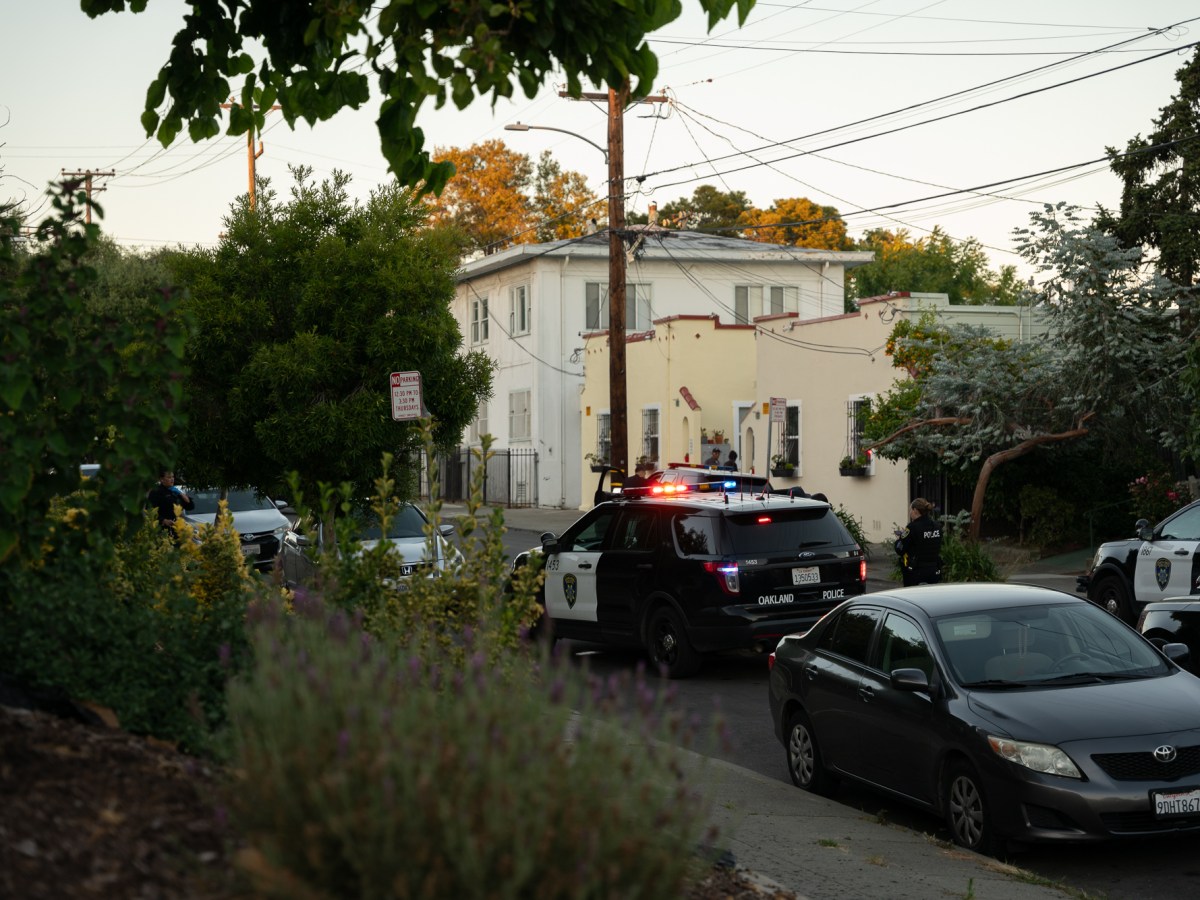For years, Oakland had an effective strategy for reducing gun violence. But the program, called Ceasefire, came unglued before the pandemic. As a result, gun violence spiked, leaving residents wondering what went wrong.
A new investigation faults Oakland leaders for abandoning Ceasefire and lays out recommendations for getting the program back on track.
The audit, which will be presented to the City Council on Tuesday, found Oakland “significantly watered down” essential elements of the Ceasefire strategy starting in 2016-2017, while Libby Schaaf was mayor. This trend accelerated in 2019 and 2020 as the city stripped away resources from Ceasefire or focused them on other programs. By 2020 the Ceasefire strategy was no longer having an impact on gun violence in Oakland and the pandemic further scrambled the ability of the police and violence interrupters to make a difference.
“What we found is the city basically walked away from the Ceasefire strategy,” said Reygan E. Cunningham, co-director of California Partnership for Safe Communities, which conducted the audit.
The Oakland-based California Partnership for Safe Communities studies gun violence and evidence-based solutions and helped Oakland launch its Ceasefire program about a decade ago. The group was also involved in managing the city program until 2020.
Related
Ceasefire, Oakland’s gun violence prevention program, is in the spotlight. What is it?
A new audit says Ceasefire’s breakdown led to a spike in shootings over the past four years. Here’s how the program works and how it started.
Mayor Sheng Thao asked for the new audit in 2023 to evaluate Oakland’s handling of Ceasefire. Kaiser Permanente and the Department of Justice helped fund the study.
The audit concludes with a series of recommendations, including changes to OPD’s approach to reviewing gun violence incidents, how the Department of Violence Prevention uses its resources, and communications across departments, among other shifts.
In response to the audit, Oakland leaders say they are making structural changes to OPD and the Department of Violence Prevention. The police department will disband the Violent Crime Operations Center, which was established by former Chief LeRonne Armstrong in 2021. The city will also seek additional funding to hire more violence prevention staff. And the mayor’s office will lead weekly meetings and restart quarterly performance updates to keep the strategy on track.
In a statement, Mayor Sheng Thao said Oakland was once the national model for reducing gun violence, and that Ceasefire is a critical component of her comprehensive community safety strategy.
“I’m proud to announce that we are resurrecting the program that was proven successful in saving lives,” Thao said.
What is Oakland’s Ceasefire program?
Oakland launched its Ceasefire program in 2013, following one of the city’s most violent years in recent history. Ceasefire’s basic insight is that a relatively small number of people drive most of the gun violence in America’s cities, and this violence isn’t random—it’s often retaliatory or based on long standing feuds between different gangs or groups. If a city focuses resources on this small group of individuals—things like job training, counseling, and social services—some will step away from conflict. Those who don’t are targeted by special teams of law enforcement who are trained in investigating gun crimes.
In Oakland, Ceasefire focused police and non-police efforts on the small number of people who were most at risk of becoming victims or perpetrators of gun violence. A 2019 study credited the program with helping to reduce shootings in Oakland. Between 2012 and 2019, shootings fell from 557 to 284.
Oakland experienced an overall 43% drop in homicides between 2012 and 2017. There was also a 31.5% reduction in Oakland gun homicides, which researchers attributed to Ceasefire.
The new audit put this in more human terms: over those years, Ceasefire helped prevent roughly 140 people from being killed by guns.
But the program appeared to become less effective starting in 2019 and 2020 as gun violence rocketed back up in Oakland. In November 2020, consultants with the California Partnership for Safe Communities informed a city board tasked with tracking violence prevention measures that life coaching services weren’t being prioritized for the people most at risk of engaging in gun violence. In 2021, Oakland experienced its most homicides in 15 years. For the past three years, Oakland has had around 120 murders each year, most involving guns, plus hundreds of other non-fatal shooting incidents.
Organizational problems with the Oakland Police Department

To understand what’s driving Oakland’s current spike in gun violence, the California Partnership for Safe Communities analyzed 388 shooting incidents between January and September of 2023. They found that there hasn’t been a major shift in the age, demographics, or social networks of the people who are most at risk. This finding, they said, is evidence that what has changed isn’t the nature of the problem—rather, it’s the city’s strategy.
Most of the people involved in shootings in 2023 were Black and Latino adult men who have been impacted by the criminal justice system and are linked to gangs or groups. This is roughly the same population that was most impacted by gun violence when Ceasefire launched over a decade ago. The auditors noted there has been a decline in the quality of intelligence regarding gang violence.
The California Partnership for Safe Communities team identified several decisions that degraded the effectiveness of Ceasefire.
One of the first setbacks occurred in 2016 after local media reported about a teenager who had been sex trafficked by Bay Area law enforcement officers, including members of OPD. At the time, OPD was collaborating on Ceasefire with an organization called Oakland Unite, which would eventually transform into the Department of Violence Prevention.
The scandal shattered public trust in the department, and by extension, the Ceasefire program. Cunningham said Oakland Unite decided to take fewer Ceasefire clients after the scandal, weakening the reach of the program.
Another significant factor behind Ceasefire’s decline was the creation of the Violent Crime Operations Center. Former Chief Armstrong announced this project in April 2021 as Oakland was reeling from 34 homicides. The VCOC focused department resources on solving crimes instead of preventing them from happening.
The new audit states that VCOC’s mission weakened Ceasefire, but it also failed to boost Oakland’s clearance rate for serious crimes—the percent of crimes in which OPD was able to identify and arrest a suspect and recommend charges to the district attorney, or close the case for another reason. Oakland’s homicide clearance rate declined from 50% in 2020 to 35% in 2022.
“My personal inclination was that it was a mistake” to create the VCOC, said Ersie Joyner, a retired police captain who ran OPD’s Ceasefire Unit during the years Oakland saw big declines in gun violence. Joyner himself was a victim of gun violence in 2021 during a robbery at a downtown gas station. He is now a senior consultant with the California Partnership for Safe Communities. “In 2024, I sit here and can tell you that I know for a fact that it was a mistake: the data shows it, the lost lives in Oakland shows it, the lack of productivity shows it.”
The VCOC also had a negative impact on OPD’s weekly shooting review—a meeting where law enforcement officers from the city and other agencies discuss recent firearm incidents. During this meeting, OPD staff are supposed to evaluate whether shootings will provoke retaliation, share intelligence about individuals and feuds that are driving violence, and make plans for arrests and interventions. The meeting also generates information that is later shared with community partners who directly intervene with the individuals most at risk of being involved in gun violence. City officials call it the lynchpin of Oakland’s Ceasefire strategy.
Auditors who observed recent meetings said the effectiveness of the shooting review has “significantly diminished” in recent years. The audit noted that OPD and outside agencies discuss shooting incidents and share intelligence, but there is no follow-up or planning to prevent retaliation shootings. The investigators said they observed little action stemming from these meetings.
“If the strategy were a car, the meeting would be the engine,” the audit states. “And in its current state, the car would be inoperable and stationary.”
Interim Assistant Chief Trevelyon Jones, who previously ran OPD’s Ceasefire Unit, said the shooting review lost its significance after the VCOC was created because the department’s priority was solving crimes, not preventing them.
“The shooting review is to help you get ahead of violence, who’s going to be the next person to pull the trigger,” Jones said. “You intervene before it gets to that point. Once we went to the VCOC model, that just became less important to the agency.”
Once the VCOC is disbanded, OPD will reestablish crime reduction teams in each of the city’s six policing areas. These teams will have more flexibility to respond quickly to emerging crime trends in their areas, city leaders said.
A breakdown in communication
The new audit also identified problems with Oakland’s system for communicating with people at risk of being involved in shootings, as victims or perpetrators, to connect them with services.
The auditors determined that the average number of people reached through “direct communications” has declined over the past three years.
Between 2020 and 2023, the city also started communicating more with family members and romantic partners linked to individuals at high risk of gun violence, hoping they would influence them to change their behavior. The audit said this strategy was flawed because the people most at risk of gun violence are often beyond the reach of relatives or loved ones.
Jones previously said pandemic restrictions also made it more difficult to hold large, in-person meetings known as “call-ins” where at-risk people could be referred to services and warned about the legal consequences of continuing to use firearms. As a result, referrals to social services and life coaching dried up. There were four call-ins in 2019 that reached 47 people. In 2020, the city held the same number of call-ins but only got 17 participants.
The call-ins have also lost some of the support that made them effective. According to the audit, these meetings used to include messages from county health experts about the physical and psychological toll of experiencing a gunshot wound. This message was missing from recent call-ins, according to the audit. So was messaging from the Alameda County District Attorney, who historically has used these meetings to inform people about the legal consequences of using firearms.
Lack of focus from the Department of Violence Prevention

The new audit also identified structural problems in the Department of Violence Prevention, a city agency set up in 2017 with the mission of reducing serious violence in Oakland.
The DVP absorbed Oakland Unite in 2020, in the process taking over a major component of the Ceasefire strategy. DVP had a mandate to reduce gun violence, but also intimate partner violence, gender-based violence, and commercial sex trafficking. Even with an expanded budget, the department was not focused on firearms exclusively. The department’s first permanent chief, Guillermo Cespedes, left in early 2023 after the city paid a settlement to a former staffer who accused him of sexual harassment and retaliation. The department lacked a permanent chief until November when Mayor Sheng Thao hired Dr. Holly Joshi.
The report says DVP needs to prioritize its gun violence work, noting that the department currently “lacks strategic focus and intentionality.” Key staff who should be working together with Ceasefire clients currently work under different chains of command and are siloed from one another. The DVP is struggling to reach and provide services to individuals at the very highest risk of being involved in gun violence, and the department’s community-based partners have expressed reluctance around working with Ceasefire clients.
The auditors said DVP needs to reconfigure itself to accommodate the typical Ceasefire client: an older, adult male who has been shot and/or has shot people. These men rarely have fixed homes because they are navigating dangerous, complex environments that force them to move constantly. Many also have experiences with traditional social services and are skeptical of providers.
The audit recommends that DVP life coaches make Ceasefire clients 70% of their caseloads, and the remaining 30% should be dedicated to individuals from demographics that are at the highest risk of being impacted by gun violence. This would be a big change at the department, which in recent years has focused more intensively on families and communities as opposed to the individuals most involved in gun violence.
The DVP also needs to dramatically increase its contacts with Ceasefire clients to have success, the audit recommends. Ceasefire clients are currently contacted 1-2 times per week for an average of one hour. The department doesn’t track whether those contacts are in person or by phone. The auditors said DVP staff need to communicate with Ceasefire clients every day by phone and meet two to four times per week.
To accomplish this goal, the audit recommends the Department of Violence Prevention combine its violence interrupter and outreach worker roles into a position that focuses on “relentless outreach.”
Joshi said she agrees with the audit’s recommendations, and that the department’s reorganization to a more proactive model should be completed by the middle of February.
The auditors also recommended that DVP maintain a staff of 30 intensive life coaches and a combination of 15 violence interrupters and outreach workers. Brooklyn Williams, the mayor’s public safety liaison, said it’s not immediately clear how much money this will require, and that the city is exploring potential sources of funding internally and externally.
“It’s important to say that the DVP was voted in 2017, the first chief came on in 2019, and things were being stood up in 2019 and 2020, so it is going to take some time to undo these things,” Joshi said, adding that DVP has experienced staff, including people involved in setting up Ceasefire. “I’m feeling confident it really is just about refocusing and putting the structures in place.”


